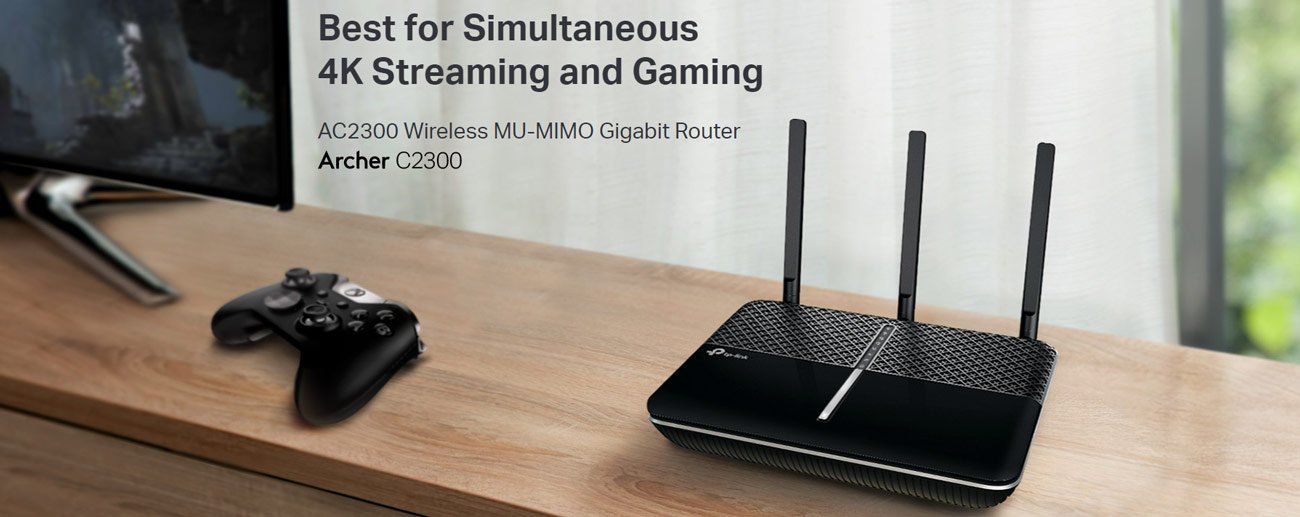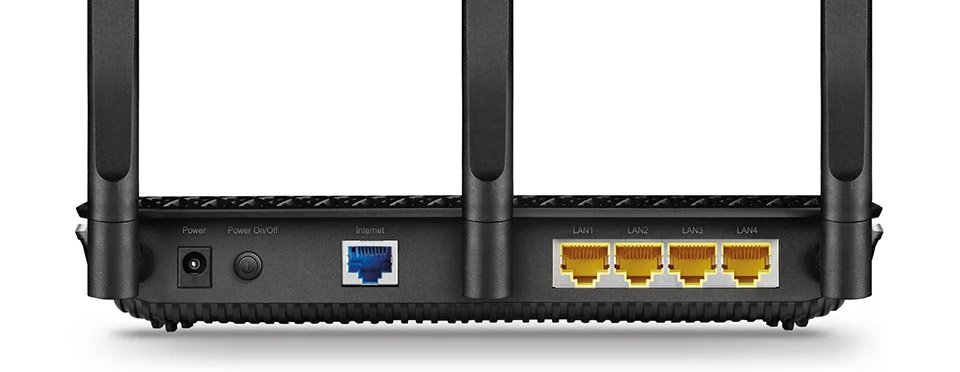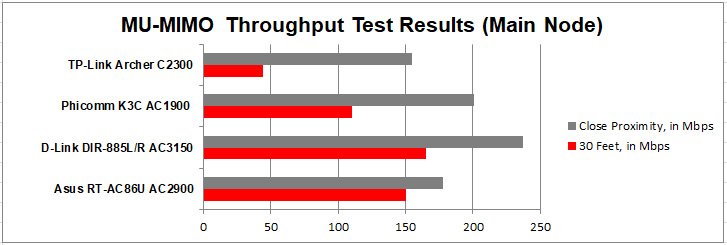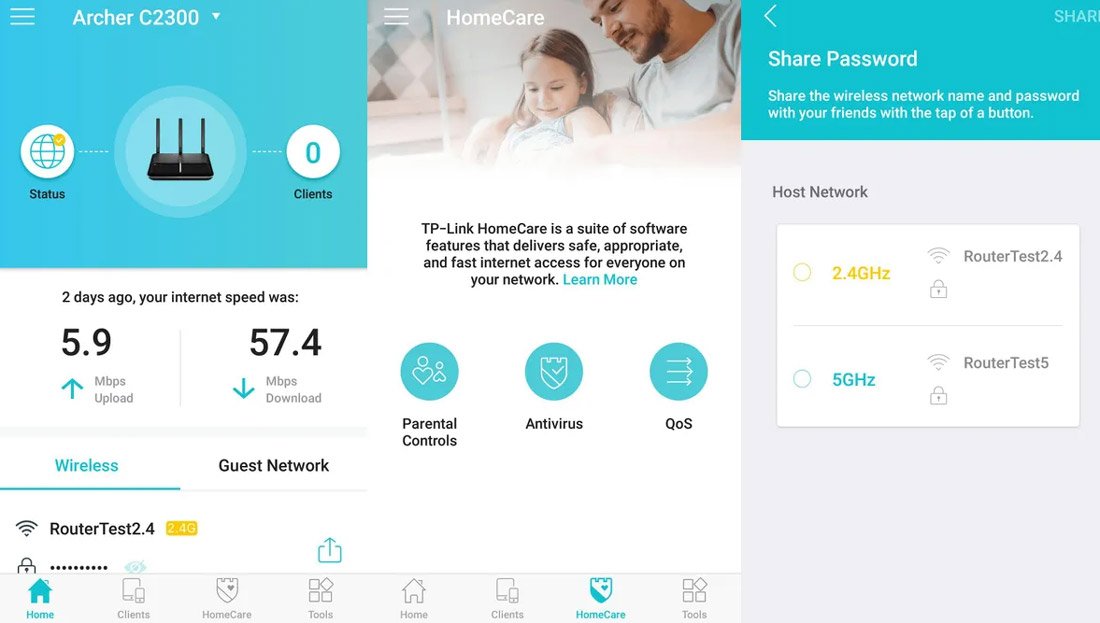The TP-Link Archer C2300 router is also sleek and has an easy-to-use menu with extra security options. It costs only 50 USD. At such a low price, you’re getting very good 5GHz speeds and features that are actually useful, like TP-Link Homecare (parental controls, network prioritisation and antivirus) as well.

TP-Link Archer C2300 Router Pros and Cons
TP-Link Archer C2300 Router Design
The TP-Link Archer C2300 looks really, really cool. At first glance it looks like any home WiFi router, but the guts inside will make you gasp. The Archer C2300 is indeed a home-centric router and it performs almost as good as top-tier models such as the Linksys WRT 32X and the Netgear Nighthawk XR500. The Archer C2300 has dimensions of 8.5 x 7.5 x 1.5 inches, about the size of cigar box, or around one-third the size of the Nighthawk XR500. Archer C2300 routers are designed to sit flat on a shelf or table, with openings on the bottom for wallmount installation.

The Archer C2300 features a BCM4365E Wi-Fi chip from Broadcom, which is capable of establishing a dual-band network and transmitting three individual streams of data. It also includes 512MB of RAM and 128MB of flash storage, with a maximum speed of up to 600 Mbps in 2.4GHz mode and 1.625 Gbps in 5GHz mode. The Archer C2300 has all the normal 1 Gigabit WAN port and 4 Gigabit LAN ports, but it has a little something else. The link aggregation function enables the same speeds to be aggregated for the connection of two Gigabit LAN ports, thus achieving an ultra high-speed of 2 Gigabit wired connection. But of course it’s not just that your connected “thing” also needs to support link aggregation. That’s a nice feature for a budget-friendly router, and the options abound with the Archer C2300: there’s a USB 3.0 port and a USB 2.0 port on this model.
TP-Link Archer C2300 Router Feature
- Watch 4K movies and game with high-speed AC2300 dual-band WiFi
- Powerful 1.8GHz dual-core 64-bit CPU with two co-processors deliver smooth and speedy connections
- RangeBoost and beamforming greatly improve WiFi connection to devices located farther away
- MU-MIMO connects more WiFi devices at once for faster performance
- Airtime Fairness equally divides attention between newer and older devices to improve WiFi performance
TP-Link Archer C2300 Router Specifications
| Brand | TP-Link |
| Model Name | Netgear AC2300 |
| Special Feature | WPS |
| Frequency Band Class | Dual-Band |
| Processor | 1.8 GHz 64 Bit Dual-Core CPU |
| Standards and Protocols | Wi-Fi 5 IEEE 802.11ac/n/a 5 GHz IEEE 802.11n/b/g 2.4 GHz |
| WiFi Speeds | AC2300 5 GHz: 1625 Mbps (802.11ac) 2.4 GHz: 600 Mbps (802.11n) |
| Guest Network | 1× 5 GHz Guest Network 1× 2.4 GHz Guest Network |
| Dimensions (W×D×H) | 8.5 × 6.5 × 1.4 in (216 × 164 × 36.8 mm) |
| Compatible Devices | Personal Computer |
TP-Link Archer C2300 Router Performance
The TP-Link Archer C2300 router was a mixed bag in our throughput tests. In the 2.4GHz close-range test, it registered 90Mbps, a bit faster than the Phicomm K3C router but a tad slower than the D-Link DIR-885L/R and Asus RT-AC86U. Scoring at 42 Mbps at 30 feet (again while using our 5GHz network) — the slowest router by far, and nearly half the speed of the D-Link and Asus routers. We also saw some drops in performance, with a high-scoring 581Mbps in our 5GHz test, but a low-scoring 185Mbps (which is considerably lower that the 100Mbps+ scores from Asus and D-Link) in our longer range tests. The Phicomm K3C finishes in last place with 137Mbps.

To measure the Archer C2300’s MU-MIMO multitasking capability, we used three identical Acer Aspire R13 laptops loaded with Qualcomm QCA61x4A MU-MIMO circuitry. The C2300 delivered 155 Mbps in close-range testing — 23 Mbps slower that the Asus RT-AC86U and 46 Mbps slower than the Phicomm K3C, but 82 Mbps slower than the D-Link Dir-885L/R It did even worse on the 30-foot MU-MIMO test, with a score of only 44 Mbps. The Feixun, the Asus RT-AC86U and the D-Link DIR-885L/R scored 110, 150 and 165 Mbps, respectively.

We load up a 1.5GB folder of music, video, photo and document files onto a USB drive, and transferred the folder to a wired desktop PC, noting the read and write speeds along the way. The Archer C2300’s read speed of 29 MBps was slower than the read speeds of the Feixun (32.6 MBps), D-Link (44.1 MBps) and Asus (38.4 MBps) routers. When we conducted a write speed test, the C2300 had a write speed of 26 MBps – better than Feixun (25.6 MBps) but not as high as D-Link (33.2 MBps) and Asus (30.7 MBps).
TP-Link Archer C2300 Router Setup
The TP-Link Archer C2300 router is easy to set up. You can use a web browser or the TP-Link Tether app; both are quick and provide similar functionality. You can also sign in or create a TP-Link Cloud account during the setup process, though only if you’d like to control the router remotely. I recommend registering—it’s free.

The only thing that seemed to go wrong during installation was that at the beginning the router did not suggest that I upgrade the firmware. First, navigate your web browser to the “Advanced” tab, click “System Tools” in the left-hand menu, click “Firmware Upgrade,” then check for updates. The most current firmware version is needed to receive the performance and security feature updates.
The web interface is nice. It is clean and neat and has three tabs for settings: Basic Settings, and Advanced Settings. The most essential functions you require are right there in each tab. Even beginners can monitor and control the network with such simple operations. This consists of a map on the network that shows connected devices, the Wi-Fi password, guest network and USB sharing to attach printers plus storage devices.




 Amazon.com
Amazon.com 



